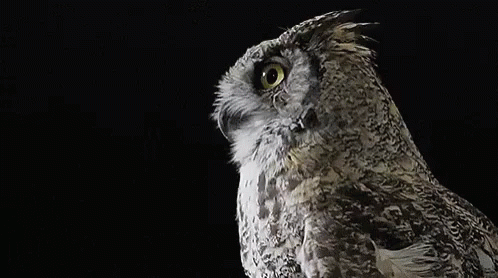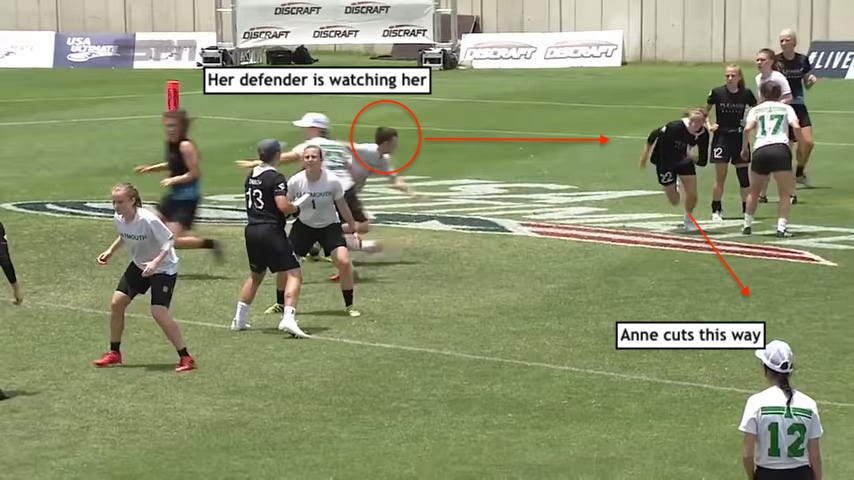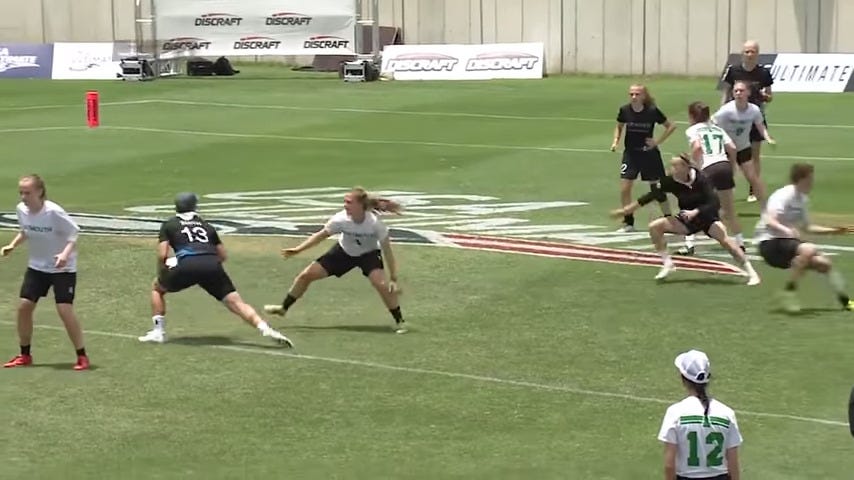An important skill for cutting is to be able to keep an eye on the person guarding you, and to notice what they are paying attention to. If they're a good defender, they'll spend some amount of time mainly focused on you, but at other times they'll be more focused on the person holding the disc (or on other offensive cutters, in order to play help defense). If you make your move during a moment when the defender isn't focused on you, you'll create separation when they react slowly.
Notice when your opponent...blinks?
As usual, let's connect this ultimate frisbee technique to what people do and know in other sports. In The Art of Learning, chess prodigy and martial arts champion Josh Waitzkin writes that he took advantage of his opponents' blinking to make his move. Yes, you read that right. And honestly, I'm not sure I actually believe it. It sounds a little ridiculous to me, and I've played competitive sports for two decades.
That being said, he seems sincere:
There are many weaknesses or tells that may be used to approach this goal—breath patterns, physical tension, inferior technical understanding, complacency, emotion, distraction, and an array of other unconscious, predictable habits can all be homed in on or combined for the desired effect. For simplicity’s sake, let’s focus on the eyes. Specifically the blink.
First of all, most people blink without knowing it, so they probably won’t consider it a weakness that may be exploited in competition. Even for top competitors, there is not much of a sense of danger associated with the blink—it happens so quickly, everything feels safe. But it isn’t. There is a small change in awareness that accompanies the flash of eyes, and a highly skilled player can train himself to exploit it....
So let’s say I am doing Push Hands with a very skilled opponent. I’m in the zone, feeling his weight, his patterns of movement, his eyes. He has certain tells. Before a blink, maybe his cheek twitches. Maybe a touch of moisture forms around his pupil. Or maybe his eyes close a tiny bit, then reopen, then blink...We are flowing. Then, on his blink, or just before it begins, I pulse into a one-two combination, left, right, into his body...If I am good, all this can happen before he has finished blinking. He goes flying onto the ground and comes up confused.
Time and again I have used this type of strategy in competition, and afterward opponents have come over to me and implied that I did something mystical. They were standing and then on the ground, and they didn’t feel or see anything occur in-between. Of course there is nothing mystical happening, just the interplay of some interesting psychological, technical, and learning principles. I read his intention to blink and then controlled his intention by determining when he would unconsciously place his weight into his forward leg. If I did this well, my movements—the one-two combination—should barely have been visible.
I don't actually think ultimate frisbee players should do this. There are a few reasons why this could work in martial arts, but doesn't make sense in frisbee. First, martial arts, being a 1-on-1 competition, is simpler, since ‘defenders’ only have one person, right in front of them, to pay attention to. In ultimate frisbee, defenders need to pay attention to other things as well (checking in on the disc, for example). So we have big distractions to take advantage of instead of needing small distractions.
Second, the "cutter" in frisbee also has to pay attention to many things (where the disc is, where the open spaces are, etc) and can't just focus on their defender so intensely that they can track their blinks. And the two competitors in a martial arts competition are going to be essentially face-to-face, while defenders in frisbee are a bit further away. Being five times further away (i.e., 6-10 feet instead of two feet), it'd be much harder to track someone's eyelids.
So instead of timing your defender's blinks, I advise just paying attention to whether your defender is paying attention to you or you paying attention to other things. Make your move in a moment when your defender isn't completely focused on you.
From the basketball archives
As always, cutting in basketball has helped inspire my cutting in frisbee. I see a lot of similarities between how cutters are defended in frisbee and how off-ball players are defended in basketball. In both cases, the defender is splitting their time/mental energy between focusing on the offensive player that they're assigned to and focusing on the player with the ball/disc. And they should be doing this. That's the best way to play defense. But it has its weaknesses, and those weaknesses can be exploited.
I've brought up this Thinking Basketball video in other posts, and here it is again. We see the same thing in basketball that we can use in frisbee: taking advantage of your defender focusing on the ball to make your cut. Watch the next twenty seconds of this video (it should automatically start at 1:37):
I want to point out two things about this video. First, the defender, Marcus Smart, is one of the best defenders in the world. He won the NBA's 2022 Defensive Player of the Year award. Although some think he didn't deserve being named the best, he's regarded as, at minimum, one of the top defensive players in the NBA. So, don't think that this technique won't work just because your defender is a strong frisbee player! Literally the best defenders in the world are vulnerable to this, because playing defense is really hard.
Second, watch how quickly the play happens. He turns his head to watch the ball, and then turns it back to check in on the man he's guarding. The head turns happen so quickly that I can't get a solid time on it with my stopwatch—it's about half a second from when he looks away to when he looks back at his assignment again. But in this split second, the cutter notices and makes his move.
To be able to take advantage of that split second, the cutter has to be paying close attention to the defender guarding him. It's not just the defense that needs to pay attention to the offense—cutters need to pay attention to the defense as well.
That being said, the cutter's ability to make that cut successful isn't only about timing and reaction speed. It's also an instinct honed over the years. He doesn't just watch Marcus Smart's head and react when he sees it turn away. I think he was actually able to predict that Smart's head was about to turn. I think that he's noticed, whether consciously or subconsciously, that the ball has been passed from a location where the ball is in Marcus Smart's (the defender) peripheral vision to a spot where it's fully out of his field of vision. That means that to see the ball, Smart will need to turn his head enough that he can no longer see the cutter at all. The cutter knows this and is anticipating it.
So the cutter is not just seeing and reacting to the action, but he's also, in my opinion, predicting the head turn based on his instincts. Because he knew the head turn might be coming, he's better able to immediately take advantage of it in the half second that Smart can't see him.
Here's another video of Jeremy Lin showcasing a similar skill. Again I've set the video to play from the relevant starting point:
Back to ultimate
Thankfully I didn't have to pore through hours of film for this article. Instead, I can point you to RISE UP Ultimate's video on cutting techniques. In the video below you can see an in-game example of this technique in action. They've even helpfully highlighted the action as it happens...their video editing skills are much better than mine:
In this video you can see similarities with the basketball example, applied to ultimate:
The defender turns their head to look at the disc. It's a quick movement, lasting half a second at most, but the cutter is prepared for it. The cutter changes directions while the defender is focusing on something else, and because of that, the defender's reaction is quite slow and the cutter creates more than enough separation.
In this video as well as in other examples, you could argue that part of what makes the cut work is that the defender is positioned sub-optimally. Did the defender really need to turn back to see the disc? Could they have been in a position where they can see both the disc and their man? But I've highlighted some of the best defenders these respective sports have to offer. Playing defense is just hard, and suboptimal defensive positioning and footwork is going to happen, even at the highest levels of the sport. We shouldn't just assume it away, we should expect defensive mistakes and know how to take advantage of them.
In Summary
You can take advantage of the naturally occurring situations where the defender isn't paying attention to you. Keeping track of the disc is necessary to play good defense (not to mention what people will do when they're playing bad defense!), so there will always be opportunities to make your move. As a cutter, one of the things you should be paying attention to is figuring out what your defender is paying attention to. If the defender isn't fully focused on you, their reaction time will be even slower than it usually is—and I've already written about how you can take advantage of reaction times to get open even when your defender is focused on you.
This skill isn't as simple as just "watching and reacting". I think that it's also predicting—watching the whole play develop and using your years of experience to predict when the defender is likely to turn their head will allow you to react much more quickly to an opportunity than if you were simply watching the defender's head and waiting for it to turn.
Updated (2022-10-20)
Here's another great example by Sean Mott in AMP's pool play game against shame. in the 2022 US club nationals. He's this guy:
The cut has a lot in common with the Jimmy Mickle cut I wrote about in Accelerate as fast as you possibly can. Mott stands there, he walks a couple steps, he stands there some more, and then his defender looks away from him towards the disc and he breaks into a full sprint going deep and catches a wide open goal:
No fakes or attacking the hips necessary, just noticing and accelerating.
Update (2024-01-29):
A clip of Anne Worth that I used in Getting open by stopping is an excellent example of responding to what your defender is noticing. Watch the clip here:
Let’s break it down in slow motion. At the start of the clip, Anne is cutting to her left (from our perspective), and her defender is watching her while also accelerating to the left:
But then her defender peeks back at the disc to see if it’s being thrown, and Anne immediately responds by slamming to a stop while her defender isn’t paying attention to her:
As a result her defender gets turned around and she gets wide open for the goal:
Update (2024-04-26):
Here is another basketball example of a player cutting when their defender looks away (found on Reddit).





